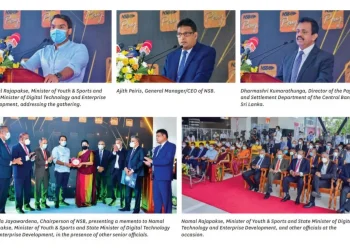Sri Lanka is on the Silk Route of the ICT Age, hence is poised to benefit from investments to be made in the transformational industries that are around the corner provided we scramble up to create a solid enabling business environment, said Lalith Seneviratne, Executive Director and Group CEO of SLT Mobitel.
In an interview with Business Today, Mr. Seneviratne said that Sri Lanka’s location at the ICT crossroads between Europe, Africa, Middle East, and East Asia combined with the nationwide infrastructure investments made by SLT Mobitel in world-class connectivity makes it an attractive investment destination for industries of the next decade. These industries that utilize Robotics, Machine Learning (ML), and Artificial Intelligence (AI) creating autonomous smart factories, operations, and workplaces of the near future can ride on the robust global fiber-optic submarine cable network consortiums SLT Mobitel has invested in, nationwide fiber connectivity, world-class data centers and cloud computing, 4G and 5G wireless networks that SLT Mobitel continually invests in.
An engineer by training, with nearly forty years of experience in the corporate field, primarily with Motorola Corporation, Mr. Seneviratne’s association with SLT Mobitel began way back in 1982 when he started his career in telecommunications at the then Sri Lanka Telecommunications Department. He was a member of the team that deployed the first software-controlled digital telephone exchanges in South Asia, thus enabling direct dialing to the main cities in Sri Lanka. In 1988, he became the head of engineering of Celltel, setting up South Asia’s first mobile telephone network.
He joined Motorola Corporation in 1990. While working in Singapore, he managed the rollout of several regional mobile telephone networks. His achievements include deploying the world’s first fixed wireless telephone network with Sri Lanka Telecom that enabled providing services to hitherto unreached areas.
By Jennifer Paldano Goonewardena.
Photography Menaka Aravinda.

As a telco veteran who has been part of the telecommunication transformation in South East Asia, what are your thoughts on the technological shift that’s happening once considered science fiction?
Communication is the basis of the existence of human society. When we think of communications, most of us go back to the telegraph and the early telephone, forgetting that human beings have always been social animals. Human civilization would not have evolved to the state it is in today if not for its inborn need to communicate. From the very basic to the advanced, these forms of communication have evolved to embrace one of the highest points in technological invention. That urge to communicate led humans to develop and adopt technology to communicate with, lessening the burden of life in the process. The laying of the transatlantic telegraph cable eliminated the transport of shiploads of cash across the Atlantic and instead facilitated the “Telegraphic Transfer” of money. A term that is still in fashion, though the technology means of money transfer has changed.
Just like today, adapting to technology has not always been easy because changing the existing reality leads to opposition from many corners. A classic example is the statement of Sir William Preece, then Chief Engineer of the British Post Office. He declared when plans for the first telephone cable across the Atlantic were made, “There are conditions in America, which necessitate the use of such instruments more than here. Here, we have a superabundance of messengers, errand boys, and things of that kind. The absence of servants has compelled America to adopt communications systems for domestic purposes.”
The telephone to become a device of mass communication was never intended. The original phone was a clever replacement for the telegraph. Then businesses realized that they could benefit from direct telephone service, but the focus of the telephone companies was not on the mass market. It took much pressure from the public before they became commercially available for installation in any home.
Next came the cordless phone and then the mobile phone leading to the smartphone that has led to the explosion in telephone ownership to the point where there are more mobile phones than the population.
With the Internet came email, and it was Hotmail that brought email to the masses, suddenly giving them this new convenience of sending a message to anyone, anywhere, quickly and easily, whenever you wanted to. Unlike the telephone, which took ages to become a domestic communication device, the adoption of the email was incredibly swift, as if society was waiting for the next best technological innovation in communication.
The ultimate evolution of the social realm for the Internet was the social network. It may seem hard to believe, but Facebook only began taking off internationally at the start of 2007. It has an incredible reach for a recent invention. Communication sells. As we are social creatures, it is what drives us forward. Today, for a great many, it is hard to imagine life before Facebook. As we have transitioned to the age of e-commerce and digitalization, the COVID-19 situation has thrust society into adapting to and managing remote transactions. From the perspective of technological innovation, we are living in a digital age. It is transforming the way we interact and the way we work.
What are the prospects for Sri Lanka in the ICT Age and being at the center of the information superhighway?
Sri Lanka is at a pivotal movement in taking advantage of its position in the global information and communications highway to be the most desired country for investment. After all, Sri Lanka is a country that has been brimming with great potential since independence. For instance, the idea for the Maruti Suzuki car had germinated in its founder after he caught sight of the locally manufactured Upali Fiat during a trip to Sri Lanka in the early 1970s. Many decades later, look at what India’s automobile industry has achieved and where we are in comparison. Another good case in point was when mobile phones were in their infancy globally; we set up the first mobile phone company in Sri Lanka in the late 1980s, when there were just a handful of nations in the world that were using mobile phones. The inherent weaknesses in our systems have often stymied potential sectors of growth, only to be overtaken by other countries. We can find refuge and blame the burden on our socalled legacy inherited from the colonial past, the religious fundamentalism and its influences, political system, and the socio-economic structure. But blaming and finding excuses will get us nowhere.
We are at the ICT crossroads between Europe, Africa, Middle East, and East Asia. With Sri Lanka in the middle, the time it takes for information to travel to any part of this rapidly developing area is equal. In technology terms, this time for a signal to travel is called latency. With this equal latency, we are best placed on processing information for any global operation in the region. During his address to the Sri Lanka Investment Forum, the President spoke on Sri Lanka’s geographic proximity to major submarine cables that transmit millions of terabytes of data, thereby making it an attractive destination for data centers and other operations that serve the IT requirements of the region. Sri Lanka’s strategic position can attract investments in some of the next-generation industries governed by robotic operation and controlled from anywhere in the world.
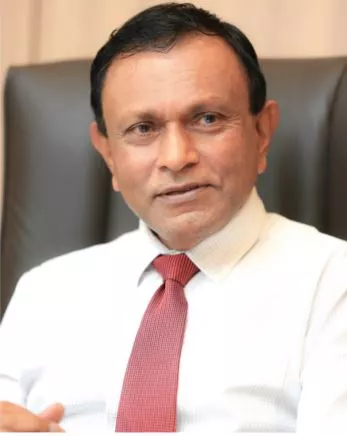
Moreover, Sri Lanka could be the staging point for automated transhipments of manufactured goods. With its increased use across industries, it is projected that by 2030 semiconductor-driven integrated ICT devices will be running most operations. We can be one of the best places for just-in-time manufacturing of semiconductors and associated devices.
Let me elaborate on Sri Lanka’s potential to be the hub of the ICT age. As I said, it takes equal time for a signal to travel to Europe or East Asia from here. Suppose we have the center of operations in Sri Lanka; we can be the hub of information processing and data storage. All the fiber optic submarine cables are within a short distance of our southern coast. Therefore, all information traveling from Europe to the East pass close to us and, in many cases, are routed through the SLT Mobitel network.
Our industrial expansion strategy must include preparation to capture the shift from today’s factory to the factory of the next decade, which will run remotely and autonomously. As I envisage, semiconductors will be one of the most significant areas of growth in the future. Likewise, with fiber-optics enabled 5G technology, organizations will be at an advantage given the flexibility to use data centers and cloud computing services managed centrally. The latency for signal transmission from one point to another will allow the elimination of onsite IT infrastructure. The future organization, which will also reflect this transformation, will not require computers, Software, and ICT specialists placed in-house, leading to lower cost and increased efficiency. We at SLT Mobitel already offer this capability to the enterprise through services such as IaaS (Infrastructure as a Service), Software as a Service (SaaS), and Platform as a Service (PaaS). Purchasing and maintaining software platforms will no longer be a necessity for enterprises. Such advanced technology enables, for example, the operation of autonomous cars. The connected networks and processing feed the car all the required real-time information such as traffic updates, intersections, communication with other autonomous cars, enabling safe navigation.
In the future, rather than labor becoming the deciding factor for efficiency and cost, a company or individual setting up a business will find the location to be the most decisive factor due to complete process automation. Automation led by communications technology will make even the smallest factory as efficient as the biggest; therefore, competition will be on the quality of the product rather than the better price tag because of the larger scale. Ideally, businesses will become more transparent and less manipulative in such a setup as small players will have equal access and chances as the more prominent players. Consumers will have transparency and the ability to choose based on what is good for the community, humanity, and the planet. Moreover, capitalism’s monopolistic nature in some business areas will reduce or cease when automation gives every industry and business, irrespective of scale, the opportunity to be efficient and reach.
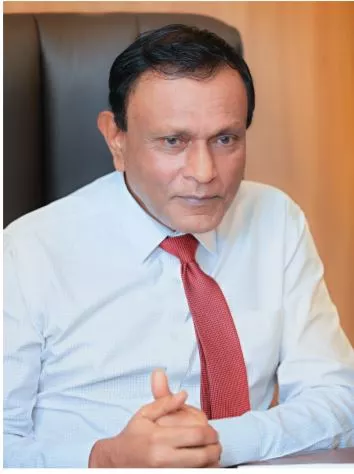
Given Sri Lanka’s strategic location for transshipment, intelligent autonomous port operations can transform our status as an efficient service provider. Achieving processes and tasks in real-time using robotics-managed sensors and intelligent software for a range of functions, from unloading and switching containers, will negate the need for people.
Suppose there is the ease of doing business and the correct policies, the connectivity that SLT Mobitel provides through its investment in data centers, the cloud and fiber-optic cables, including the 2021 investment of 50 million dollars with a consortium of large global operators to build the latest submarine fiber-optic communication cable from Europe to East Asia. In that case, investors can easily be lured to Sri Lanka. SLT Mobitel has built the foundation of the ICT infrastructure of the future. Sri Lankans, in general, the bureaucrats, the politicians, and the Government must be cognizant of the reality of the country’s excellent position in the global communications technology highway to harness it. Global trendsetters with foresight like Elon Musk and Jack Ma know that this change will overtake the world in the next decade. If Sri Lanka is to take the tide, then our systems need to be swiftly revamped to embrace the opportunity around the corner.
As long-term investors envisage this future scenario, they are making investments to take advantage of these changes. The big question is, are we ready to create the environment for investors to consider Sri Lanka as one of the best places to do business? Globally, because of its readiness, Israel is known as The Start-Up Nation. Sri Lanka can be equal if only we take the bitter medicine. After all, metaphorically speaking, half a Sri Lankan river will fulfill the entire water needs of Israel given their efficiency, but we just have not got our act together.
How will new technologies and automation help reverse the decline in the quality of life and the environment, mitigating the darker side of capitalism, reducing inequality, and devastating global conflicts?
The steam engine gave birth to the industrial revolution. It was considered a miracle for that era as it could do what humans or horses could not in terms of power and non-stop operation. The steam engine derived efficiency from its size, making it cheaper and easier to produce goods on a larger scale. The larger the factory or establishment, the higher the productivity, which meant that people had to migrate to the cities to fill in the jobs required to meet the demand for increased output. On the strength of the steam engine, large grimy industrial towns came into being. Mass migration from the rural areas to cities that became bigger and bigger occurred. That led to people living in dismal conditions, exploited, and working long hours under deplorable working conditions and low wages. These abysmal working conditions combined with air pollution with fossil fuel burning machines led to many chronic health conditions. There was scant regard for environmental pollution. The darker side of capitalism operated as the industrial revolution accelerated through the years. The coming of the electric motor eased the situation a bit. However, gas-guzzling vehicles and coal-powered power stations continue to tear apart the fragile ecosystem combined with a larger and larger tax on earth’s natural resources.
However, today we can expect a change in this hitherto detrimental world order. As we move into autonomous, decentralized, and remote manufacturing, where labor will no longer be a factor, the state of a nation’s ICT infrastructure and global connectivity will matter most. A small factory will be as efficient as a large one. Big cities will slowly disappear. Mass of people congregating in one place will not happen as technology will connect them from wherever they are. The current COVID-19 situation is a good example, demonstrating the possibility of working remotely rather than commuting to the city. It has been a learning curve for SLT Mobitel, with its nearly nine thousand employees not required in the office as much as before, literally negating the need for extensive physical space. However, although the pandemic has artificially forced this on us, humans will only be needed for innovation and management at best as automation across industries and services sets in.
Smart Grid enabled by the ICT infrastructure will allow electricity to be switched in all directions, unlike the one-way legacy grid in Sri Lanka that requires most of the electricity to be generated from larger and increasingly polluting coal power stations. If the electricity sector rises to the challenge and builds the intelligent grid along with liberalization of generation, like the liberalization of telecommunications, more and more renewable distributed generation of power can happen, and nearly all of the electricity needs can be met with renewables. Environmental pollution will recede. SLT Mobitel is ready with the required ICT infrastructure for the smart grid and autonomous distributed power stations. With intelligent and efficient factories, manufacturing will switch to economical and equitable production methods. That will reduce the need for crowded work floors, replaced by robotics and AI. Operations will become decentralized with investment in renewable energy, semiconductors, robotics, and fiber-optics that support infrastructure for the coming economy. Less travel will lead to a further reduction in pollution. That, in turn, would lead to an improvement in the quality of life. With big cities experiencing a decrease in human and automobile traffic, it will help improve the quality of life of the people. The planet will be able to regenerate and sustain itself when there are environmentally friendly practices. With a declining population due to the need for only specialized human beings, natural resources’ overuse and depletion will reduce.
I believe that in the next ten years, the health sector will be one of the most crucial areas that will benefit from these advancements. Likewise, the agriculture industry can be mechanized and automated and will use precision electronic techniques to tackle issues such as pest control. That would negate the need for harmful pesticides, thereby again benefitting the environment and the people from exposure to toxic substances. With such precision-based automation of the agriculture industry, we can expect improvement to people’s health by reducing the ingestion of food containing harmful and poisonous properties and the growing of quality food.
The value to society of present and coming advances in information and communications technology is immense. Twenty years ago, no one expected this many advancements to take place in technology. However, SLT Mobitel has always strived to anticipate the need and invested in the technology the country requires to be on par with the best. However, to be a best in class, the country requires equal strive by all the sectors, including the bureaucracy, political hierarchy, and people.
ICT transformation to continue at an accelerated pace requires a more and more skilled workforce. Here the industry has clearly understood that there is a gap. While multifaceted organizations need to address this, a network of SLT Mobitel Training Centres engages in training. Here we would like to have more collaboration with the IT sector of the country.
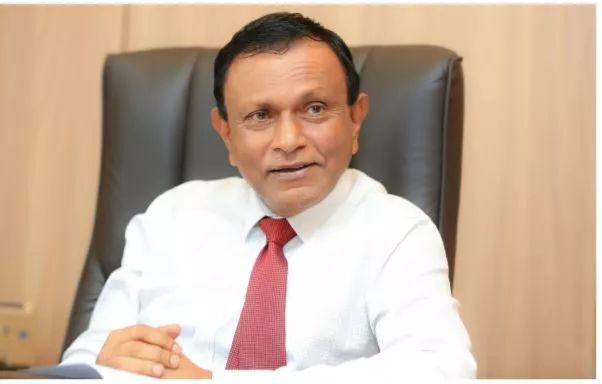
Given the circumstances and the underlying systemic issues that we encounter, how long do you think it will take for Sri Lanka to take on these changes?
In 1982, Motorola turned to Sri Lanka to set up its first factory in Asia. However, the fallout from the July 1983 ethnic riots resulted in Motorola setting up multiple factories in Malaysia. The thousands of employment opportunities that Malaysia won, Sri Lanka lost. When we set up the first mobile telephone company in Sri Lanka, only a few globally were using a mobile phone, and our neighbors were not even close to us. The ease of doing business was different where it was more of an environment that did not allow the bureaucracy to impede investments and new businesses. Today, we are introducing more regulations assuming that it is the right way to do things. Rules are required, but it would not serve the purpose when the bureaucracy stymies businesses, leading such entities to navigate the system indirectly or bypass Sri Lanka altogether.
Companies and individuals are reluctant to invest in Sri Lanka because of the various agencies to be navigated through and each not coordinating with the other. Investments are integral to economic growth. Efficient systems are vital for companies to take advantage of the benefits and incentives and do so the correct way. Even internally, the obstacles are many. For instance, in Sri Lanka, it is a challenge to engage in justin-time manufacturing due to a lack of transparency in applying rules and regulations. There are too many obstacles. Today, more than ever, we have to make hard and fast decisions. We can learn from other countries. Singapore, for example, developed not because it had more capable people than Sri Lanka. Singapore developed because it had leaders and ministers who put the country and its people before them and built the system to create an enabling environment. People in Singapore don’t break the law because they know that there is no place to escape from the arm of the law. As a nation, we must understand the brutal fact that nothing falls out of the sky unless we take steps to facilitate growth.
It is up to individual countries and their people to choose to take the tide of opportunities the next decade brings at the end of the day. I think the countries that begin to embrace this change will achieve success by 2030. And it will be a different world for such countries, while those that fail to adopt these changes will perish or be static. While for Sri Lanka, it is within its reach, the decision is with us, the establishment, the leadership, and policymakers. The decisionmakers, in general, must understand and believe that this change is necessary if they want investment, which is the only option left to take the country to a trajectory of growth.
As much as new technology infrastructure requires investment, can we expect substantial revenue in return?
Investors in telecommunications service providers recognize ICT as a capital-intensive sector or a reinvestment-intensive industry. Therefore, even in global Telco, the dividend ratio is far lower than most industries because constant reinvestment in technology is a prerequisite. The technology of today will be different tomorrow. So, we may have to invest the same amount we invest today, tomorrow as well. But SLT Mobitel is on a growth trajectory and has been ready to embrace every significant change. We can invest on a bigger scale, and we can also reinvest if Sri Lanka is ready.
Ideally, we must provide concessions to sectors that add value to society. These are issues that we as a country need to focus on seriously. Many important issues are left that way because it hurts somebody or offends the establishment. To move on to what we envisage, we need to change this trajectory. As a telco, we are doing what is essential to take Sri Lanka to the next level. We have invested in technology, and we will continue to invest in the future as well.
How will the future of agriculture automation function? Do you think agriculture automation will be possible only for companies and not for the rural farmer that the Government is trying to uplift?
If we don’t change the way the people operate in the agriculture sector in the country, the next generation will not want to continue. The systemic problems that have persisted and continue to persist thwart our ability to move over to the next better level. A farmer can make a living income from his land. However, the involvement of many intermediaries, post-harvest loss, debt due to microcredit issues, over dependency on artificial fertilizer and pesticides all weigh down on profitability. In many problematic areas, ICT tools such as eCommerce platforms, automatic and electronic-based pest control, and autonomous harvesting machines can ease the farmer’s burden. If we do not enable the farmer to take full advantage of ICT, there is the serious risk of larger corporations acquiring land and amalgamating it to a larger extend. Such big companies will take full advantage of ICT technology and displace the rural farmer.
You have pointed out the direction for Sri Lanka and the issues that are keeping ICT from moving to the next level. Can you tell us how this could happen and the role of policymakers? What is the sort of paradigm shift that should take place?
Some of the issues we face today come from the colonial past, and we need to reverse them. The colonial rulers are responsible for engraining some of our self-centric practices due to the old divide and rule practice. Then there is the legacy of past feudalism.
D G J Hennessey, an Englishman who was a Deputy Inspector General of Police in the 1930s upon embracing a new life in the jungle off Horowpathana, in his book, the Green Aisles, notes that in the time of Sri Lankan kings, it was the responsibility of the householder to grow enough food for the family. And if he were to deliberately not cultivate, there was a severe punishment. But what did the British do? They said that they would feed the villager if they didn’t have enough to eat. That was the culture of dependency first created by colonials. Of course, there is no point blaming them now as they are long gone. But this is one example of how our work ethic has got molded over the years.
As a recent example of development, China is a country where all the segments of society and industry go together. Their electricity industry is as efficient as their telecom industry. Their arts and sports are of equally high standards. We in Sri Lanka may claim that we have the best this or that in the world. But is there anything any uniformity across all sectors? We have so much unharnessed potential left. We touched on electricity before. Renewable energy component of our electricity generation has steadily gone down to well below 50 percent from the 90 percent it was in the 1990s, leading to one of the highest electricity rates in the world. Yet here we live in Sri Lanka, abundant with sources of renewable energy. We cannot harness such potential because no one is accountable, and no targets are enforced. To change this, we have to move in unison and with one vision.
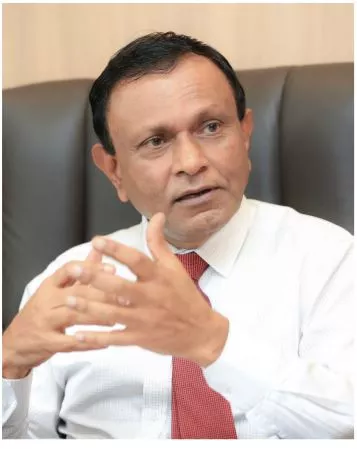
Today, there is much talk about attracting investment, but we lack intervention to create ease of doing business. Companies have to go through multiple agencies for approvals. Even for a Telco like us, putting up, say, a crucial tower to provide accessibility is challenging, sometimes taking more than a year for approval. The establishment must realize that imposing more regulations from time to time doesn’t make the system transparent and efficient. With more restrictions, the less scrupulous the system becomes; many will try to bypass the process for swift approvals, thereby turning away genuine investors.
Those in power positions assume that every rule or regulation introduced is for the benefit of the investor, consumer, or country. Yes, ideally, it would be so if implemented to the letter. When it is not, the net result is that the system is bypassed. The visionary engineer Ray Wijewardene who first designed the two-wheeled had a straightforward solution. A specific checklist against which any initiative is compared to its benefit to the country regarding national security, health and wellbeing, food security, and energy security. If all the boxes are ticked, you are allowed to go ahead while meeting the relevant standards. Of course, the standards will be checked and enforced fairly and equally. I believe that we need a paradigm shift. We need learned and committed groups of people who list down the priority changes we need to make. The politics of Sri Lanka has to be overcome primarily without the multiple forces that stymie the potential. It is crucial to shift methodically from one level to the next. We need a blueprint on how best to get about it. Considering the current economic situation, we may even need to allow small businesses to start up with a fiveyear moratorium on labor and inland revenue regulations and customs regulations to kick start the growth.
What are the challenges confronting Telcos in providing services amidst restrictions to movement?
The gloom created by the travel restrictions in response to the pandemic can easily prompt people to lose confidence and hope. A persistent lament that we watch and read in the media is about a student or a group of students unable to attend virtual classrooms because of inadequate broadband coverage. Of course, certain areas are not provided with coverage because the number of people may be small. At the same time, 95 percent of the population has access to the wireless broadband. The media, unfortunately, does not put that in context. The challenges faced when erecting towers, and in many cases, public protests against towers are not highlighted when reporting.
As an industry, we intend to highlight the role of what we have done. Most often, what we have not done receives the spotlight, and not vice-versa. In response, we have initiated a Telco industry forum because there are certain common areas that we can collectively work on, such as showcase our investment in technology and cooperate in prioritizing investments, sharing resources.
For the first time, the Government is actively getting involved through the Telecommunications Regulatory Commission (TRC). Through an initiative called “Connect Sri Lanka” led by the Director-General TRC, an aggressive program to rollout 100 percent connectivity district by district over two years. For this initiative, the TRC will plow back the Telecommunication Development Levy currently paid as a tax to the Government by all the consumers.
We have provided free of charge data to the Government education platform eThaksalawa. Students can receive online content, and teachers to conduct online classes for their respective students. A similar data-free option is provided for University students through the University Grants Commission online teaching platform. Further, SLT Mobitel, through the TRC, will aggressively assist the Ministry of Education in providing high-speed fiber broadband to every one of them over ten thousand schools in Sri Lanka over one year.
Sri Lanka, you said, is in the Silk Route of the ICT Age. Can you tell us the current role of SLT Mobitel and your future investments in accelerating this transformation?
SLT Mobitel is the National Telecommunications Service Provider of Sri Lanka that reaches over 95 percent of the population with a combination of fixed and mobile access. We have invested over the years with much foresight ensuring that we are part of the information highway. As part of that, we have invested in consortiums that build fiber-optic submarine communications cables that connect Sri Lanka to the rest of the world. The result of investment in those is that we also get to be part of that return. So, we make a substantial profit by investing and further investing in new cable systems.
We have invested in virtual infrastructures such as data centers and the cloud capability to make computing and processing efficient for companies, including the Government, banks, and other critical enterprises, to run their businesses efficiently while maintaining data privacy, sovereignty, and resiliency. If not, these companies would have had to invest in their infrastructure at a high cost and on a less robust basis. We are building capabilities that all companies, big or small in Sri Lanka, can take advantage of.
In Sri Lanka, SLT Mobitel is the only company that has laid primary fiber optic cables from Point Pedro to Dondra Head, providing high-speed broadband access to any enterprise that needs it.
We have an aggressive plan to provide high-speed fiber broadband to nearly 50 percent of homes in Sri Lanka over the next three years, reaching one million homes by the end of this year.
SLT Mobitel has a joint venture between Singapore Telecom and Orange Marine of France to operate a submarine cable service facility in Galle. The Depot is the only one of its kind in South Asia. The cable repair ship Asia Restorer is stationed in Galle as part of the facility. The strategic location of the Depot enables swift submarine cable repair and maintenance work in the region as all submarine cables from Europe to Asia and the Far East run within close reach of Galle. No other telecommunications service provider can match this capability.
SLT Mobitel considers its mission as national, which I believe other organizations too should follow. It is this ethos that guides our investments. We will invest over 60 billion rupees in Fiber to the Home technology. As a result, people will work from home, control a factory remotely, invest in a factory located far away, and students and adults will have the facility to study from home. That is a longer-term investment made with the country’s future trajectory in mind. As we plan to provide fiber connectivity to nearly five million homes, it will take five to six years to accrue returns from that investment. Our investors are fully supportive of this long-term investment strategy. We believe that other companies can have the country and its people and the future at their core when making investment decisions.
No other majority government-owned utility or entity in the country generates as much profit, runs efficiently to create a profit, and invests in technology as SLT Mobitel. We invest with the long-term in mind. If you read what the world’s visionaries are thinking today, most of them believe that COVID-19 will be a turning point. Individuals have asked whether the COVID-19 pandemic is the Pearl Harbor moment. I also firmly believe in that analogy. For those who want to think beyond the current situation, Pearl Harbor offers valuable lessons. Action is imperative. As I see it, we are sitting on the defining moment of our nation’s history if only we understand and take advantage of our position to invest with 2030 and beyond as the horizon. And 2030 is not that far away, and it will be a far different world for those nations who believe in this and act on this.


